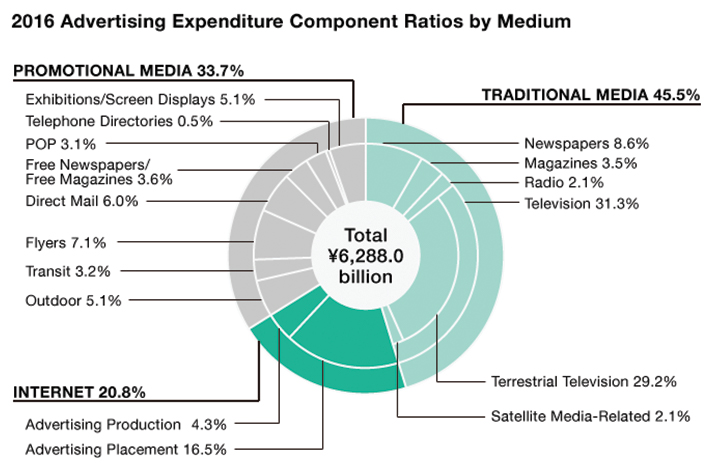
Btrax Design Company > Freshtrax > 5 Best TV Adver...
5 Best TV Advertisements in Japan and What Makes Them So Great
Although Japan’s marketing industry has experienced rapid growth and a shift towards digital media, television is still considered the dominant force in advertising. According to Dentsu’s 2016 advertising expenditure report, the production costs for TV commercials alone account for 31.3% of Japan’s total advertising expenditure and has seen a 2% increase this last year.

https://www.dentsu.com/knowledgeanddata/ad_expenditures/
Companies maintain multi-million yen budgets on TV advertising because it is key for growing and establishing a prominent brand. Not only is there a strong correlation between the increase in TV advertising spending and sales, but TV advertising is the most effective advertising medium in increasing market share.
To most foreigners, Japanese TV advertisements are commonly viewed as creative and bizarre. The foundation of an effective TV advertisement in Japan needs to be memorable, be culturally relevant, appeal to various emotions, and deliver a clear message to the audience. Characteristics proven to increase an advertisement’s effectiveness include humor, puns, and parodies.
Here are 5 best TV advertisements in Japan that incorporated these qualities:
1. Firefly Man
This award-winning commercial for Ocedel Lighting, begins with a father struggling to keep the lights on for his family. He ventures on a five-year journey and returns as a firefly to provide the lighting his family and village needs. Even with the tragic ending, Ocedel Lighting delivers a simple, yet clear message — switch to LED lighting so your father doesn’t have to become a bug — in a comical manner. At the same time, there are deeper and more significant meanings behind this commercial. Perhaps different from other nations, fireflies (hotaru) are well liked in Japanese culture, although they symbolize both love and war. “The Light of the Firefly (Hotaru no Hikari)” is a popular Japanese song bidding farewell. These fireflies represent the love the father has for his family, and also the sacrifice he is willing to make for them. We can see from this commercial how significant the imagery of love and sacrifice is in the Japanese culture.
2. The Power of Music
On a couple’s wedding day, the bride’s father comes on stage and performs a beautiful melody. By showing flashbacks, we see how the melody was once often played by the bride’s late mother and how the father and daughter’s relationship slowly began to drift apart after the mother passed away. The father, wanting to do something special for his daughter’s wedding, learns the melody to bring back the memories of her mother, honoring her memory at the wedding. Tosando, a music school in Japan, shows how the power of music is able to repair and bring a family closer again. Like the previous commercial, we see how important love and family is in Japanese culture.
3. Deceiving Nurse
This advertisement begins with a nurse walking into a hospital ward and catching one of the patients with alcohol. As the nurse looks for the alcohol, the patient looks at the nurse’s badge and suddenly becomes terrified. The nurse begins taking off her make-up and we begin to understand why he is so terrified. But what is this ad about? Gin no Sara, a premium sushi delivery company, tells its audience that unlike many fake and deceiving things in life, they deliver the freshest, purest, most honest, and best sushi around. Bet you didn’t see that one coming.
4. Family and Bento
Part of Tokyo Gas’ “Family Bond” series, this touching bento commercial shows a mother carefully planning and preparing different bento boxes for her son over the past three-years. Regardless of how distant and ungrateful the son might be, deep down he is thankful but doesn’t know how to express his gratitude until the last bento. Although most teenagers everywhere go through a time of being distant with their parents and others, Japanese adolescents are perceived as more distant and less outspoken than Western cultures. Regardless of the cultural differences, Tokyo Gas, a natural gas provider, has a clear message and goal to help families bond through food; by using their natural gas.
5. Scary Girl
You know a commercial is scary when it comes with a disclaimer and health warning. This commercial begins with a group of people driving in the winter night and stopping when they see a little girl standing in the middle of the road. Suddenly, the girl slams herself onto the windshield. Extremely frightened, they scream and reverse the car. The next scene zooms in on the girl holding a laptop advertising Autoway’s tires. Although this was an unexpected tire commercial, Autoway did a great job in getting their message across — no matter what terrifying situation you are in, our tires will get you safely away. What makes this advertisement stand out is the use of fear to provoke emotion, which makes it unique and memorable. If you didn’t guess already, the scary girl in the commercial is a reference to the well-known fictional character Sadako Yamamura from the movie “Ring” (1998).
Summary
Despite the rise in digital and mobile marketing, TV advertising remains the most efficient and reliable source in establishing and growing a brand in Japan. From these top 5 TV advertisements, we can see how incorporating themes in Japanese culture and stimulating various emotions is an effective strategy to make a lasting impression and deliver a clear message.
Author

Ivan Ding
Ivan is a marketer at a biotech company here in Silicon Valley. He graduated with a BA in Sociology and minor in Business from the University of California, Irvine. During his free time, he enjoys traveling and learning about different cultures.







